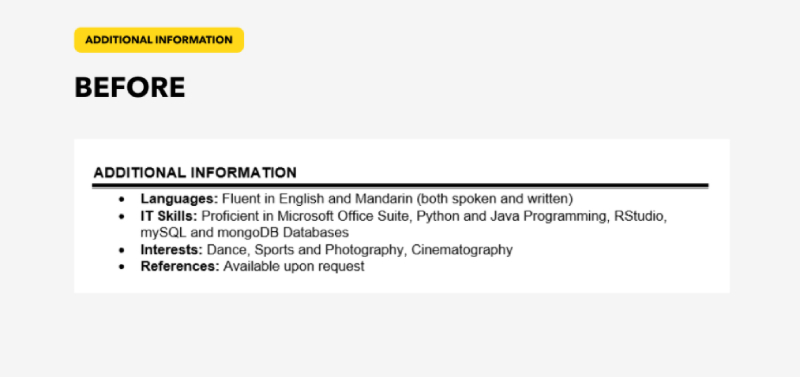A step-by-step resume revamp of an actual resume by a resume coach

Many jobseekers have a run-of-the-mill resume, but not because they are mediocre or lacking.
They have simply yet to master the art and science behind writing a resume.
People tend to write their resume based on the things they want to tell recruiters.
They are eager to showcase their strengths, but end up leaving out the information that recruiters actually care about.
[[nid:506716]]
A great resume should encompass both.
We had an expert resume coach review an actual resume and comment on what was well done and also what was missing. Pick up the tips and advice and use them to revamp your own resume.
For this resume revamp, we have decided to use a resume from a university student – so that we can showcase what you can do if you have limited work experience.

Let’s look at this resume from top down.
Note: Sensitive information have been omitted to protect the identity of the individual.

This is a good header. It provides the necessary details and omits all else irrelevant.
How to make it great: Include your LinkedIn profile.
If the employer is interested in you, the recruiter would love to check out your LinkedIn profile. Be sure to include your LinkedIn URL in your header.

This is a very clean and concise way of listing your education. Briefly mention all the certificates you’ve attained and share the expected date of graduation for those that you are still pursuing.
However, instead of jumping straight into your accolades, there are a few key points that are missing.
How to make it great: Include an Executive Summary, your Areas of Expertise, and your Personal Traits.

Note: All 3 categories should stand on their own.
The executive summary is a short paragraph that showcases your unique selling proposition.
Under areas of expertise, you would want to highlight your strengths as succinctly as possible. All of them should be just keywords, not sentences.
When elaborating your personal traits, aim to help the recruiter get to know you better as a person. In this section, go big on your soft skills.
To get a better idea of how they look like and what should go within each section, check out The Anatomy Of A Perfect Resume (2020).

If possible, always put your work experiences on top of your education. Those are considered the highlight of your resume. From your work experience, you will be able to better illustrate your strengths, skillsets, and what you can bring to the table if they were to employ you.
There are of course exceptions. For individuals with absolutely no working experience, focus on your education and really elaborate on the strengths and capabilities you’ve cultivated through your CCAs or leadership positions.
How to make it great: Prioritise your work experiences.

After sorting out the arrangement, now let’s dive into details.

Without jumping straight into telling the recruiters what is it you do, first describe the company. Don’t assume that everyone will know what it is your company does.
How to make it great: Include a description of what the company does. This helps the recruiter see where you fit into the bigger picture.

It is also not enough to just talk about what you do there. Keep in mind you are not just another cog in the wheel.
How to make it great: Separate your responsibilities from your achievements. Make it clear what your job scope is, then bring in notable achievements you’ve accomplished in your time there.


This is where you will put all of the miscellaneous information that are not directly relevant to the job description.
Stuff like 'References' and 'Interests' are often found under this category.
This may be counter-intuitive, but do not include your interests unless they are directly related to your line of work. In extreme cases, your interests may result in your elimination before you even land an interview.
For example, your interest in fishing may be viewed as animal cruelty if your employer happens to advocate strongly for animal rights.
Also, employers all know that references are available upon request. You do not have to include them.
There are a few cases where individuals even directly names their references.

Doing so can actually backfire on you. They know that this particular person is sure to speak highly of you, and they may request for references that are not listed on your resume.
How to make it great: Remove your interests and references entirely.

Just by knowing what to include in your resume makes a world of difference.
Now imagine if you know how to properly word them to fully showcase what you are capable of.
This article was first published in TalentTribe.asia.